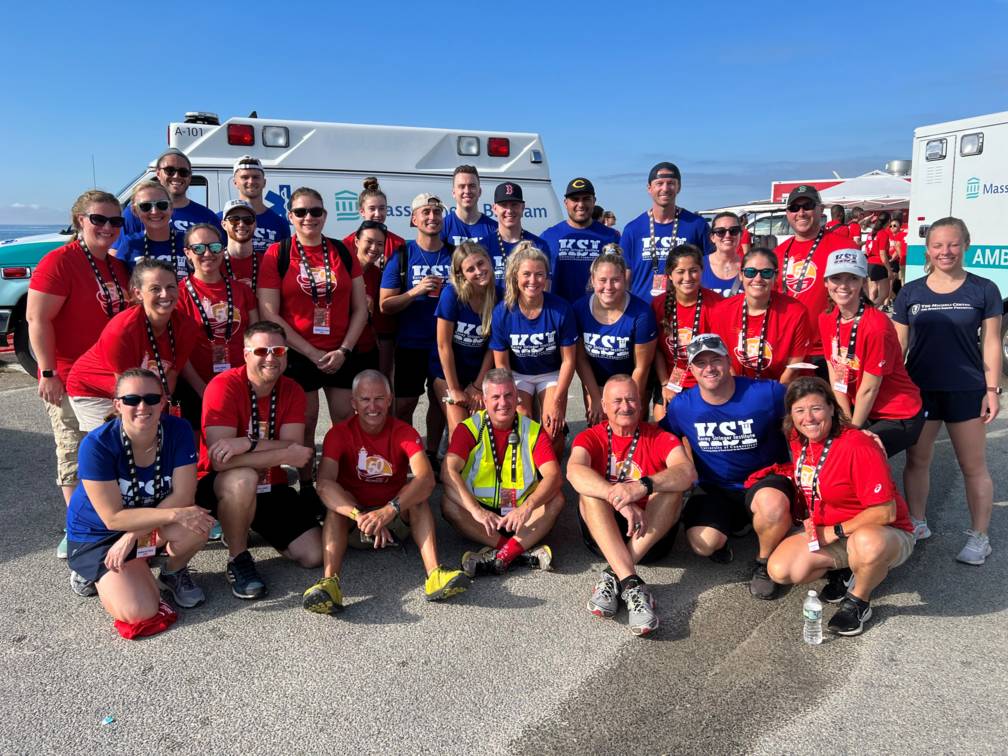Dr. Kevin Miller and KSI Medical Team Help Save 39 Lives from Heatstroke

Dr. Kevin Miller, a professor in the Department of Health and Human Performance, joined an interdisciplinary medical team to provide medical care and perform research at the 50th annual Falmouth Road Race. Over 10,000 athletes from all over the world compete in the 7-mile road race on Cape Cod each year. Dr. Miller and the medical team saved 39 athletes from deadly exertional heatstroke; a condition identified when the body temperature exceeds 105 degrees Fahrenheit occurs alongside central nervous system dysfunction. Dr. Miller and his colleagues from the University of Connecticut, the Korey Stringer Institute, West Virginia University, University of Michigan, and Central Michigan University collected data about heatstroke patients' perceptions of how heatstroke is recognized and treated.
Exertional heatstroke is triggered by physical exertion, particularly in hot and humid conditions. Many individuals who participated in the Falmouth Road Race this year experienced a variety of symptoms associated with exertional heatstroke. Dr. Miller states, “What makes the Falmouth Road Race so interesting to study regarding heat illness is because it’s a short race that occurs every August in Cape Cod. It is a common environment for exertional heatstroke to occur based on the heat, humidity, and race distance. People are determined to perform well and tend to push themselves to achieve the best outcome.”
Each year in the United States, three to four child athletes die from exertional heatstroke during the summer months. In 2017, a sixteen-year-old student named Zachary Martin collapsed from heatstroke at football practice and died 11 days later. This tragedy sparked controversy in the state of Florida and the greater athletic community due to the lack of medical knowledge that could have saved Martin’s life. Another high-profile tragedy occurred in 2018 when Maryland offensive lineman Jordan McNair showed signs of extreme exhaustion and had difficulty standing upright while running a set of 110-yard sprints. McNair was found to have a body temperature of 106 degrees Fahrenheit at a local hospital before he died of heatstroke. The presence of knowledgeable medical personnel, such as athletic trainers who follow best practices for people experiencing exertional heatstroke can treat the life-threatening condition and prevent fatalities.
Dr. Miller and the Falmouth Road Race medical team utilized the best practice medical procedures to identify and treat the participants who suffered from exertional heatstroke. Everyone who experienced forms of heat-related illness had a rectal temperature check to assess their body core temperature. There were also several cold-water immersion tubs (50 gallons) under a stationed medical tent to immerse participants whose rectal temperatures were above 105 degrees Fahrenheit. Dr. Miller states, “The biggest takeaway from the Falmouth Road Race each year is the importance of quick recognition with rectal temperature and using cold-water immersion to treat exertional heatstroke. Many people who suffer from exertional heatstroke are given intravenous therapy (iv) or ice packs that are placed on their skin to cool them down, but those practices are ineffective.”
Dr. Miller emphasized the importance of rectal temperature checks and cold-water immersion to decrease a core body temperature when it is above 105 degrees Fahrenheit. Dr. Miller says, “When we follow the best practice which is taking the person’s rectal temperature and then immerse them in cold water, we can 100 percent save that person’s life.” Although these guidelines are effective, many people express their discomfort with checking rectal temperatures and use other more common medical procedures to identify a person’s temperature. Dr. Miller states, “Other body temperature sites, like oral or ear temperature, often underestimate body temperature which can lead to a misdiagnosis. Research has shown an oral and ear temperature can be one to five degrees different than a rectal temperature. In contrast, we have over 300 cases of confirmed exertional heatstroke victims that were saved by early recognition through rectal temperature checks and cold-water immersion. We never want something that might make us feel uncomfortable dictating what is best for the patient.”
The signs of exertional heatstroke have a wide range and mimic those of other conditions. Dr. Miller says, “Someone’s symptoms who is suffering from heatstroke may mimic a diabetic emergency or head injury. One individual may appear to be calm and mildly fatigued while others display erratic behaviors.” When an ambulance is called for a victim experiencing heatstroke, it is critical for the person to receive immediate medical attention prior to emergency medical services (EMS) arrival. A person suffering exertional heatstroke needs to be immersed in cold water to cool their core body temperature for before going to the hospital. Dr. Miller states, “The first instinct when someone collapses from heatstroke is to call an ambulance and rush the individual to a hospital for treatment. The average response time for an EMS is around 9-to-10 minutes with an additional 10-to-15-minute ambulance ride. The determining factor regarding whether someone with exertional heatstroke will live or die is how long their temperature is above 105 degrees Fahrenheit. Our mantra is to cool first and transport second.”
Dr. Miller and his colleagues who volunteered at Falmouth Road Race will gather data by analyzing the responses of individuals that were treated for exertional heatstroke. Dr. Miller says, “The data we are collecting will inform clinicians about what people think about exertional heatstroke so that we can better educate the general populous and athletes. We are aware of what students, coaches, and athletic trainers think about exertional heatstroke, but we have little data on what actual heatstroke patients think and know about heatstroke.” The data should answer common questions to help clinicians inform the public about the importance of understanding exertional heatstroke. Dr. Miller believes the combination of education regarding exertional heatstroke and athletic trainer supervision at athletic events can save lives and prevent heat-related illnesses and fatalities. Dr. Miller says, “We need to put the right tools and resources in place for athletic trainers to provide aid and save lives. Every athletic event should have an athletic trainer present.”